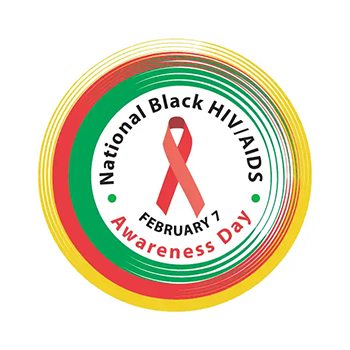National Black HIV/AIDS Awareness Day
Engage, Educate, Empower: Uniting to End HIV/AIDS in Black Communities
National Black HIV/AIDS Awareness Day (NBHAAD) is dedicated to raising awareness about the disproportionate impact of HIV on Black and African American communities. First observed in 1999, NBHAAD highlights the importance of community involvement and improved access to HIV education, prevention, testing, and treatment services. This year’s theme is “Engage, Educate, Empower: Uniting to End HIV/AIDS in Black Communities.”
According to the Centers for Disease Control and Prevention (CDC), national HIV prevention efforts led to a 10 percent decrease in the number of Black or African American people diagnosed with HIV between 2017 and 2021. Despite this decrease, HIV continues to have a disproportionate impact in Black communities. In 2021, 40 percent of new HIV diagnoses occurred in Black and African American people, although this population accounted for only 13 percent of the total population. This disparity is even wider in the South, where Black and African American people accounted for 49 percent of new diagnoses in 2021 but comprised only 19 percent of the population. In addition, the majority of new HIV diagnoses occur in Black or African American gay, bisexual, and other men who have sex with men (MSM). Within this population, young Black and African American MSM are the most affected subpopulation—three of four new HIV diagnoses in Black and African American MSM are among people ages 13-34.
The National Institutes of Health (NIH) HIV research program, coordinated by the NIH Office of AIDS Research (OAR), supports research to reduce HIV-related disparities based on race and ethnicity. This includes efforts to better understand and address HIV-related stigma and discrimination, which can discourage people from accessing HIV services. NIH HIV research also looks at the most effective ways to encourage Black and African American populations to access HIV testing, prevention, and treatment services.
Social Media
Use the hashtag #NBHAAD to follow the conversation on social media. Download graphics and find sample social media posts to promote HIV prevention, testing, and treatment in Black and African American communities on the HIV.gov NBHAAD webpage and NBHAAD on the CDC Awareness Days webpage.

Additional Resources
NIH Office of AIDS Research
- FY 2021-2025 NIH Strategic Plan for HIV and HIV-Related Research (NIH HIV Strategic Plan): The NIH HIV Strategic Plan provides a roadmap for NIH to guide HIV and HIV-related research and direct HIV research funding to the highest-priority areas to help end HIV. Reducing HIV-related health disparities is one of several priorities for HIV-related research.
- HIVinfo.NIH.gov is an online resource, maintained by OAR, that offers up-to-date HIVinformation to the general consumer, people with HIV, and those who care for them. HIVinfo provides HIV-related infographics and many other resources. This HIV Source African American collection provides resources on HIV research, prevention, testing, and treatment in Black communities.
- National Black HIV/AIDS Awareness Day: Taking Action to Improve Health Outcomes: This 2022 OAR Director’s Blog post highlights how the NIH HIV research program leads to improved health outcomes for people affected by HIV in the Black community and includes several examples of NIH-funded projects to address HIV in these communities and encourage Black scientists to focus on HIV research.
HIV.gov
HIV.gov provides information on the U.S. government’s HIV response. HIV.gov aims to expand visibility of relevant federal HIV policies, programs, and resources and to increase knowledge about HIV and access to HIV services to people with HIV or at risk of HIV acquisition. The NBHAAD webpage provides information about HIV in Black communities and links to related federal resources. In addition, this HIV.gov webpage provides information on the impact of HIV on racial and ethnic groups, including Black and African American groups.
CDC
CDC’s Awareness Days webpage provides resources to help spread awareness about HIV in Black communities, as well as information on CDC’s Let’s Stop HIV Together campaign empowers communities, partners, and health providers to promote HIV testing, prevention, and treatment. Also, learn more about HIV in Black communities.
